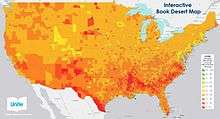Book desert
A book desert is a geographic area (country, state, county, city, neighborhood, home) where printed books and other reading material are allegedly hard to obtain, particularly without access to an automobile or other form of transportation.[1] Some researchers have defined book deserts by linking them to poverty and low income, while others use a combination of factors that include census data, income, ethnicity, geography, language, and the number of books in a home.[2]
Initiatives that increase the availability of books by such measures as bookmobiles and librarians on bicycles have been offered as possible solutions to book deserts, as have Little Free Libraries and offering children's literature available online, free of charge.[3]
Background and research
In the past, researchers have studied how the absence or scarcity of books impact how a child's early literacy and language skills develop.[4][5] The term "book desert" came into regular use in the mid-2010s and the social enterprise Unite for Literacy is credited as having coined the term.[2] Unite for Literacy created an operational definition of a book desert when they published the U.S. Book Desert Map: A geographic area (country, state, county, census tract) where it is predicted that a majority of homes have less than 100 printed books. In March 2014, James LaRue, director of the American Library Association's Office for Intellectual Freedom and the Freedom to Read Foundation, used the term in an issue of American Libraries, where he described the term as applying to houses with 25 or fewer books in them and discussed ways to lessen or eradicate the problem.[6]
In July 2016, professors Susan B. Neuman and Naomi Moland published a study in Urban Education, where they examined how the lack of printed reading material among low-income and poverty stricken neighborhoods impacts early childhood development and used the term to describe areas and homes with little access to written materials.[1] This study built upon other research Neuman had conducted in 2001 on the same topic and the researchers found few stores in Detroit, Los Angeles, and Washington, D.C.; the focus areas of their research had print resources for children ages 0 through 18.[7] Of those stores, many were dollar stores.[7] The Atlantic reported that in 2015 Neuman and JetBlue Airways held an experiment to foster literacy by providing book vending machines in a low-income Washington D.C. neighborhood. Over 20,000 books were given away, prompting Neuman to conclude that the neighborhood's parents did care about their children's education but lacked "the resources to enable their children to be successful."[7]
Contributing factors
Multiple factors are credited as contributing to the formation of book deserts, the most frequently highlighted of which tends to be poverty and low income. Other factors tend to include language and geography, as some areas lack access to bookstores or public or community school libraries that would provide books.[8] Book store closures due to bankruptcy or other financial difficulties are also occasionally cited as a contributing factor, when the closure leaves the area without a bookseller.[9]
Depictions

Unite for Literacy has developed a book desert map of the United States powered by Esri's ArcGIS platform, which provides a visual presentation of the lack of books in the nation, states, counties and census tracts.[10] To create the map, Unite for Literacy performed a statistical analyses of data from the National Assessment of Educational Progress and the American Community Survey. Data used in the map includes the number of books in 4th graders' homes, average community income, ethnic diversity, geographic location and home language. Unite for Literacy unveiled the map during the Clinton Global Initiative America (CGI America) meeting held in Denver, Colorado, in June 2014.
References
- Neuman, Susan B.; Moland, Naomi (2019). "Book Deserts The Consequences of Income Segregation on Children's Access to Print". Urban Education. 54: 126–147. doi:10.1177/0042085916654525. ISSN 0042-0859.
- Silvy, Tyler (July 30, 2014). "Searching for oases in Weld's so-called book desert". Greeley Tribune. Archived from the original on September 14, 2016. Retrieved August 6, 2016.
- Gilbert, Jeff (June 26, 2016). "Literacy initiative aims to eliminate 'book deserts'". Dayton Daily News.
- Evans, M. D. R.; Kelley, Jonathan; Sikora, Joanna; Treiman, Donald J. (2010-06-01). "Family scholarly culture and educational success: Books and schooling in 27 nations". Research in Social Stratification and Mobility. 28 (2): 171–197. doi:10.1016/j.rssm.2010.01.002.
- Poulton, Lizzie (July 7, 2010). "A book of their own: how owning books affects children's literacy". Literacy Trust. Archived from the original on September 18, 2016. Retrieved 2016-08-06.
- LaRue, James (March 4, 2014). "The Price Is Right at Unite for Literacy". American Libraries Magazine. Retrieved 2016-08-06.
- Wong, Alia (July 14, 2016). "The Children Who Grow Up in 'Book Deserts'". The Atlantic. Retrieved 2016-08-06.
- Santelli, James (July 30, 2016). "Warren group works to fight 'book desert' phenomenon". WKBN. Retrieved 2016-08-06.
- Gelles, David (April 14, 2012). "Store closures create US 'book deserts'". The Financial Times. Retrieved August 6, 2016 – via Academic OneFile.
- "Unite for Literacy library".
Further reading
- Evans, M.; Kelley, J.; Sikora, J. & Treiman, D. J. (2010). "Family scholarly culture and educational success: Books and schooling in 27 nations", Research in Social Stratification and Mobility 28(2): 171–197. doi:10.1016/j.rssm.2010.01.002.
- Evans, M.D.R., Jonathan Kelley & Joanna Sikora (2014). "Scholarly Culture and Academic Performance in 42 Nations." Social Forces 92(4): 1573–1605. doi:10.1093/sf/sou030.
- Gollner, K., Webster, T. & Nathan, L. "The Neighborhood Book Exchange: Community Catalyst or Media Hype?" (PDF). iConference 2013 Proceedings (University of British Columbia/University of Illinois IDEALS): 697–700. doi:10.9776/13323. Retrieved 2013-05-08.
- Gwinn, Mary Ann (August 2, 2015). "'Like a human bird feeder': Readers share Little Free Library tales". The Seattle Times. Retrieved 6 September 2015
- Moland, Naomi and Susan B. Neuman. "Book deserts: Unequal Access to Print Resources in America's Cities." To be submitted to Urban Education.
- Neuman, S. B., & Celano, D.. (2001). "Access to Print in Low-Income and Middle-Income Communities: An Ecological Study of Four Neighborhoods". Reading Research Quarterly, 36(1): 8–26. JSTOR 748125. doi:10.1598/RRQ.36.1.1.